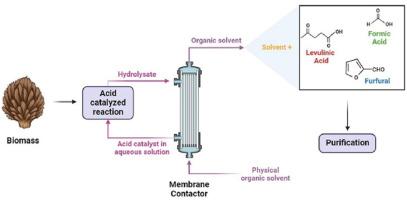Mass transfer in membrane contactors for separating levulinic acid, formic acid, and furfural from biomass hydrolysate with physical organic solvents
IF 9.5
引用次数: 0
Abstract
Levulinic acid (LA), formic acid (FA), and furfural were separated from an aqueous solution using membrane contactors with organic solvents. The aqueous mixture, simulating LA production's biomass hydrolysate from, contained 7 % LA, 3 % FA, and 4 % FF by weight. The mass transfer coefficients of solutes followed the order: methyl isobutyl ketone (MIBK) > toluene > 2-propanol > 1-octanol, while solute extraction followed FF > FA > LA. FF extraction was more dominated by the resistance of aqueous phase compared to other solutes. The membrane mass transfer resistances could not be neglected and affected the overall mass transfer performance. Using the membrane contactor could improve the FF selectivity compared to an equilibrium extraction technique. The FA selectivity over LA was investigated and a reactive organic solvent such as Aliquat336 in MIBK as well as replacing the organic phase with another aqueous phase enhanced the FA selectivity.

用物理有机溶剂从生物质水解物中分离乙酰丙酸、甲酸和糠醛的膜接触器传质研究
采用膜接触器与有机溶剂分离乙酰丙酸(LA)、甲酸(FA)和糠醛。模拟LA生产的生物质水解产物的水相混合物,按重量计含有7% LA, 3% FA和4% FF。溶质的传质系数顺序为:甲基异丁基酮(MIBK) >;甲苯比;丙胺比;1-辛醇萃取,溶质萃取依次为FF >;足总比;洛杉矶。与其他溶质相比,水相的阻力对FF萃取的影响更大。膜传质阻力不可忽视,影响着膜的整体传质性能。与平衡萃取技术相比,膜接触器可提高FF的选择性。研究了FA对LA的选择性,发现在MIBK中加入活性有机溶剂(如Aliquat336)以及用另一水相代替有机相可以提高FA的选择性。
本文章由计算机程序翻译,如有差异,请以英文原文为准。
求助全文
约1分钟内获得全文
求助全文

 求助内容:
求助内容: 应助结果提醒方式:
应助结果提醒方式:


